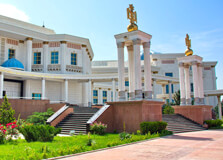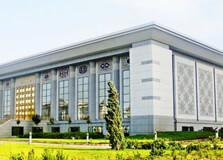
- Home
- Travel Packages
- Top Destination
-
Travel Attraction
By Category
Top Attraction

- Travel Agents
- Car Rentals
- Hotels

The Turkmenistan National Museum is one of the most important cultural landmarks in Ashgabat, Turkmenistan. Established in 1998, this museum offers visitors a comprehensive insight into the rich history, culture, and heritage of the country. The museum showcases a vast collection of artifacts that span several millennia, from the ancient civilizations of the region to the modern history of Turkmenistan. It is an ideal destination for anyone looking to understand the cultural and historical evolution of this fascinating Central Asian country. How to Reach Turkmenistan National Museum The Turkmenistan National Museum is located in the capital city of Ashgabat, which is easily accessible by various modes of transportation. The museum is situated in the city center, so it can be reached by taxi, ride-sharing services, or public transport. Ashgabat also has a well-connected network of buses, so taking a bus that passes near the museum is a good option. If you're staying in a central hotel or guesthouse, the museum is just a short drive or walk away. Weather in Ashgabat Ashgabat has a desert climate, characterized by hot summers and mild winters. The best time to visit the Turkmenistan National Museum is during the spring (March to May) or autumn (September to November), when the weather is comfortable for walking and exploring. Summer months can be extremely hot, with temperatures exceeding 40°C (104°F), so it's advisable to wear light, breathable clothing and carry plenty of water if you visit during this season. Winter temperatures are generally mild, but it’s still recommended to wear layers to stay warm. Timings of Turkmenistan National Museum The Turkmenistan National Museum is open every day from 9:00 AM to 5:00 PM, except on national holidays. It is closed on Mondays. The museum's schedule allows enough time to explore its extensive collections and exhibits. Visitors are encouraged to arrive early to take full advantage of the museum's exhibits, as it can get busier in the afternoons. For those interested in a more in-depth experience, guided tours are available during the opening hours. Why the Turkmenistan National Museum is Famous The Turkmenistan National Museum is famous for its vast and diverse collection that covers the entire history of the country, from ancient times to the present day. The museum is divided into several sections, including archaeology, ethnography, natural history, and Turkmenistan's Soviet era. The exhibits highlight the cultural heritage of the Turkmen people, showcasing items such as traditional clothing, carpets, ancient coins, and artworks. The museum’s unique displays also emphasize the nomadic traditions of the Turkmen people and the evolution of their society over the centuries. Entry and Visit Details Visiting the Turkmenistan National Museum is generally free for tourists. There is no entry fee, but it is recommended to bring identification for possible entry checks. The museum has an organized and user-friendly layout, with clear signage in both Turkmen and English. Visitors are encouraged to take a guided tour for a deeper understanding of the exhibits and the country’s history. The museum's knowledgeable staff can provide insights into the rich heritage of Turkmenistan and guide you through the exhibits. The museum also offers audio guides in various languages, making it more accessible to international visitors. History of the Turkmenistan National Museum The Turkmenistan National Museum was founded in 1998, soon after the country gained independence from the Soviet Union in 1991. The establishment of the museum was part of Turkmenistan's efforts to preserve and celebrate its unique history, culture, and traditions. It was designed to reflect the country's aspirations to promote national pride and cultural awareness. The museum's collection includes artifacts from various periods, including the ancient Parthian Empire, the Seljuk Turks, and the Turkmen people’s nomadic past. Today, it serves as a vital institution for education and cultural preservation in Turkmenistan. Architecture of the Turkmenistan National Museum The architecture of the Turkmenistan National Museum is a striking example of modern design combined with traditional Turkmen elements. The building itself is a grand, white-marble structure that reflects the nation's rich architectural heritage. The museum's facade is decorated with intricate carvings and symbols that evoke Turkmen cultural identity. Inside, the museum is spacious and well-lit, with expansive halls that house the diverse collections. The design of the museum creates an atmosphere of reverence and respect for the cultural treasures it holds. Things to Do Around the Turkmenistan National Museum In addition to exploring the museum's exhibits, visitors can enjoy a stroll around the surrounding area, which is home to several other key landmarks in Ashgabat. The Museum is located near the Independence Monument and the Palace of Peace and Neutrality, which are both worth visiting for those interested in learning more about Turkmenistan’s modern history. The nearby parks and gardens also provide a relaxing space to unwind after a museum visit. Additionally, the local markets offer opportunities to shop for traditional Turkmen handicrafts, such as carpets, textiles, and jewelry. Facts about the Turkmenistan National Museum The museum was established in 1998, shortly after Turkmenistan became an independent country. It houses over 150,000 artifacts, including ancient coins, textiles, jewelry, and archaeological finds from different periods of Turkmen history. The museum has several permanent and temporary exhibitions that showcase Turkmenistan's rich culture, history, and natural environment. The building is designed with traditional Turkmen motifs, incorporating elements like marble, gold, and intricate patterns that reflect the country's cultural identity. It is one of the largest museums in Central Asia, attracting both local and international visitors. Tips for Visiting the Turkmenistan National Museum Visit in the morning to avoid crowds, especially if you’re visiting on weekends or public holidays. Wear comfortable shoes, as the museum is large, and you may be walking for extended periods of time. If you’re unfamiliar with Turkmenistan’s history, consider taking a guided tour to learn more about the exhibits and their significance. Carry water, especially if you’re visiting during the warmer months, as temperatures in Ashgabat can be quite high. Don’t forget to bring a camera, as there are plenty of opportunities to capture the beautiful exhibits and architecture. Conclusion The Turkmenistan National Museum is a cultural treasure trove that provides visitors with an enriching experience about the history and heritage of Turkmenistan. With its impressive architecture, extensive collections, and informative exhibits, the museum offers a fascinating journey through time, from ancient civilizations to modern Turkmenistan. Whether you're a history enthusiast, an art lover, or simply curious about Turkmenistan, this museum is a must-visit destination in Ashgabat. Take the time to explore its collections and learn about the rich cultural fabric that defines this remarkable country.
Explore More
The Turkmen Carpet Museum, located in Ashgabat, the capital of Turkmenistan, is one of the most fascinating cultural attractions in the country. The museum is dedicated to the art of carpet weaving, which is a deep-rooted tradition in Turkmen culture. With over 2,000 carpets on display, ranging from ancient to modern designs, the museum offers a comprehensive insight into the significance of carpet weaving in Turkmenistan's history and daily life. The museum is a must-visit for those interested in textiles, art, and Central Asian culture. How to Reach Turkmen Carpet Museum The Turkmen Carpet Museum is located in the heart of Ashgabat, which is easily accessible by various forms of transportation. The most convenient option for visitors is to take a taxi or ride-sharing service from your accommodation in the city. Public buses also run close to the museum, making it accessible for those traveling by public transport. If you are staying in a central area, it’s possible to reach the museum on foot, as it is located near other key landmarks of Ashgabat. The museum’s central location means that it is well-known, and locals can easily guide you there if needed. Weather in Ashgabat Ashgabat experiences a desert climate, characterized by hot summers and mild winters. The best time to visit the Turkmen Carpet Museum is in the spring (March to May) or autumn (September to November) when temperatures are more comfortable, averaging between 20-25°C (68-77°F). Summer in Ashgabat can be extremely hot, with temperatures regularly exceeding 40°C (104°F), making the cooler months the best time to explore the museum and the city. Winters in Ashgabat are generally mild, with daytime temperatures rarely falling below 10°C (50°F), but it can be chilly in the evenings, so be sure to dress warmly during this period. Timing of Turkmen Carpet Museum The Turkmen Carpet Museum is open every day from 9:00 AM to 5:00 PM, with a lunch break from 12:00 PM to 1:00 PM. It is advisable to arrive early to make the most of your visit, as you will have more time to explore the intricate exhibits without the crowds. The museum is closed on national holidays, so it is a good idea to check the local calendar before planning your visit. Audio guides and guided tours are available during opening hours, which can help you gain a deeper understanding of the cultural and historical significance of the carpets on display. Why the Turkmen Carpet Museum is Famous The Turkmen Carpet Museum is famous worldwide for its unparalleled collection of carpets, which showcase the incredible artistry and skill of Turkmen weavers. Carpet weaving is an ancient tradition in Turkmenistan, and the museum displays carpets that date back to the 18th and 19th centuries, along with contemporary works. The carpets on display are known for their vivid colors, intricate patterns, and symbolic motifs, each representing the diverse regions and tribes of Turkmenistan. The museum also hosts temporary exhibitions and special events that highlight the ongoing importance of carpet weaving in Turkmen culture. The museum’s collection is considered one of the largest and most comprehensive in the world, making it an essential stop for those interested in textiles and cultural heritage. Entry and Visit Details Entry to the Turkmen Carpet Museum is relatively inexpensive, with tickets available for a modest fee. International visitors may need to show identification and pay a slightly higher price than locals. The museum offers guided tours in multiple languages, including English, which can enhance your experience by providing in-depth knowledge about the history and significance of the carpets. The museum is spacious and well-maintained, providing an enjoyable environment for visitors to explore the exhibits at their own pace. There are also souvenir shops inside the museum where you can purchase miniature carpets and other local crafts to take home as a reminder of your visit. History of the Turkmen Carpet Museum The Turkmen Carpet Museum was founded in 1994 to preserve and promote Turkmenistan’s rich tradition of carpet weaving. The museum is housed in a building designed to reflect the cultural significance of the carpets displayed inside. The museum’s collection began with a small selection of carpets but has since grown into one of the largest collections in the world. The exhibits highlight the craftsmanship and artistry involved in creating Turkmen carpets, from the design process to the weaving techniques used. Carpets were historically used in Turkmen society for various purposes, including as symbols of wealth, status, and even as dowries. Over the years, the museum has played a key role in educating visitors about the importance of this art form and its role in Turkmen history. Architecture of the Turkmen Carpet Museum The architecture of the Turkmen Carpet Museum is designed to complement the beautiful carpets it houses. The building is an elegant, modern structure that blends traditional Turkmen motifs with contemporary design elements. The exterior of the museum is made of white marble, a common material used in Turkmenistan’s architectural landmarks. Inside, the museum features spacious galleries with high ceilings, which create an open and airy atmosphere. The layout is designed to allow visitors to fully appreciate the intricate details of each carpet on display. The museum’s carefully curated lighting highlights the vibrant colors and patterns of the carpets, ensuring that every piece is showcased in the best possible way. Things to Do Around the Turkmen Carpet Museum When visiting the Turkmen Carpet Museum, there are several other attractions in Ashgabat that are worth exploring. Nearby, you can visit the Ashgabat Arch of Neutrality, a striking landmark that symbolizes Turkmenistan’s foreign policy of neutrality. The Independence Monument and the Palace of Peace and Neutrality are also within reach, offering more insight into Turkmenistan’s modern history. For those interested in shopping, the nearby markets offer a wide variety of traditional Turkmen goods, including carpets, textiles, and jewelry. Exploring the gardens and parks around the museum is another way to relax and enjoy the surroundings after your visit. Facts about the Turkmen Carpet Museum The museum houses over 2,000 carpets, including some of the finest examples of Turkmen weaving. Many of the carpets on display are centuries old, dating back to the 18th and 19th centuries. The carpets are made using traditional techniques, with some of the oldest carpets woven by hand using wool, silk, and cotton. The Turkmen Carpet Museum is considered one of the best museums of its kind in the world, with a reputation for preserving and showcasing the art of carpet weaving. The museum is located in the heart of Ashgabat, making it easy to visit alongside other important landmarks in the city. Tips for Visiting the Turkmen Carpet Museum Arrive early to avoid crowds and have plenty of time to explore the exhibits at your own pace. Consider taking a guided tour, especially if you want to learn more about the history and techniques behind the carpets on display. Wear comfortable shoes as you may be walking for an extended period of time while exploring the museum’s many galleries. Check out the museum’s gift shop for high-quality Turkmen carpets and other handmade crafts as unique souvenirs. Don’t forget to take photos, but be sure to respect any photography restrictions that may be in place in certain areas of the museum. Conclusion The Turkmen Carpet Museum in Ashgabat is a unique and fascinating destination that showcases one of Turkmenistan’s most cherished art forms. Whether you are an art lover, a history enthusiast, or simply curious about the culture of Turkmenistan, this museum offers a deep and meaningful exploration of the country’s weaving traditions. The museum’s stunning collection of carpets, its modern architecture, and its educational value make it a must-see attraction in Ashgabat. Don't miss the chance to visit this incredible museum and experience the rich heritage of Turkmen carpet weaving firsthand.
Explore More